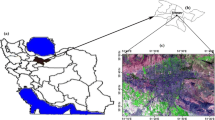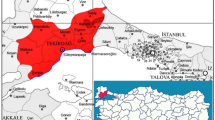Abstract
Accuracy in the prediction of the particulate matter (PM2.5 and PM10) concentration in the atmosphere is essential for both its monitoring and control. In this study, a novel neuro fuzzy ensemble (NF-E) model was proposed for prediction of hourly PM2.5 and PM10 concentration. The NF-E involves careful selection of relevant input parameters for base modelling and using an adaptive neuro fuzzy inference system (ANFIS) model as a nonlinear kernel for obtaining ensemble output. The four base models used include ANFIS, artificial neural network (ANN), support vector regression (SVR) and multilinear regression (MLR). The dominant input parameters for develo** the base models were selected using two nonlinear approaches (mutual information and single-input single-output ANN-based sensitivity analysis) and a conventional Pearson correlation coefficient. The NF-E model was found to predict both PM2.5 and PM10 with higher generalization ability and least error. The NF-E model outperformed all the single base models and other linear ensemble techniques with a Nash-Sutcliffe efficiency (NSE) of 0.9594 and 0.9865, mean absolute error (MAE) of 1.63 μg/m3 and 1.66 μg/m3 and BIAS of 0.0760 and 0.0340 in the testing stage for PM2.5 and PM10, respectively. The NF-E could improve the efficiency of other models by 4–22% for PM2.5 and 3–20% for PM10 depending on the model.














Similar content being viewed by others
Data availability
Data for the study is available and can be found at https://uk-air.defra.gov.uk/data/maryleboneroad.
References
Ahmed AA, Pradhan B (2019) Vehicular traffic noise prediction and propagation modelling using neural networks and geospatial information system. Environ Monit Assess 191:190. https://doi.org/10.1007/s10661-019-7333-3
Arhami M, Kamali N, Rajabi MM (2013) Predicting hourly air pollutant levels using artificial neural networks coupled with uncertainty analysis by Monte Carlo simulations. Environ Sci Pollut Res 20:4777–4789. https://doi.org/10.1007/s11356-012-1451-6
Azeez OS, Pradhan B, Shafri HZM, Shukla N, Lee CW, Rizeei H (2019) Modeling of CO emissions from traffic vehicles using artificial neural networks. Appl Sci 9:313. https://doi.org/10.3390/app9020313
Cai M, Yin Y, **e M (2009) Prediction of hourly air pollutant concentrations near urban arterials using artificial neural network approach. Transp Res Part D Transp Environ 14:32–41. https://doi.org/10.1016/j.trd.2008.10.004
Çaydaş U, Hasçalik A, Ekici S (2009) An adaptive neuro-fuzzy inference system (ANFIS) model for wire-EDM. Expert Syst Appl 36:6135–6139. https://doi.org/10.1016/j.eswa.2008.07.019
Codur MY, Atalay A, Unal A (2017) Performance evaluation of the ANN and ANFIS models in urban traffic noise prediction. Fresenius Environ Bull 26:4254–4260
Doǧan E, Akgüngör AP (2013) Forecasting highway casualties under the effect of railway development policy in Turkey using artificial neural networks. Neural Comput & Applic 22:869–877. https://doi.org/10.1007/s00521-011-0778-0
Elkiran G, Nourani V, Abba SI, Abdullahi J (2018) Artificial intelligence-based approaches for multi-station modelling of dissolve oxygen in river. Glob J Environ Sci Manag 4:439–450. https://doi.org/10.22034/gjesm.2018.04.005
European Environment Agency (2012) Road Traffic’s Contribution to Air Quality in European Cities-ETC/ACM Technical Paper 2012/14. Road traffic’s contribution to air quality in European cities ETC/ACM Technical Paper 2012/14 — Eionet Portal (europa.eu). Accessed 20 Oct 2020
Fan J, Yue W, Wu L, Zhang F, Cai H, Wang X, Lu X, **ang Y (2018) Evaluation of SVM , ELM and four tree-based ensemble models for predicting daily reference evapotranspiration using limited meteorological data in di ff erent climates of China. Agric For Meteorol 263:225–241. https://doi.org/10.1016/j.agrformet.2018.08.019
Feng X, Fu TM, Cao H, Tian H, Fan Q, Chen X (2019) Neural network predictions of pollutant emissions from open burning of crop residues: application to air quality forecasts in southern China. Atmos Environ 204:22–31. https://doi.org/10.1016/j.atmosenv.2019.02.002
Ghaffari A, Abdollahi H, Khoshayand M et al (2006) Performance comparison of neural network training algorithms in modeling of bimodal drug delivery. Int J Pharm 327:126–138. https://doi.org/10.1016/j.ijpharm.2006.07.056
Gulia S, Khanna I, Shukla K, Khare M (2020) Ambient air pollutant monitoring and analysis protocol for low and middle income countries: an element of comprehensive urban air quality management framework. Atmos Environ 222:117120. https://doi.org/10.1016/j.atmosenv.2019.117120
Jahani B, Mohammadi B (2019) A comparison between the application of empirical and ANN methods for estimation of daily global solar radiation in Iran. Theor Appl Climatol 137:1257–1269. https://doi.org/10.1007/s00704-018-2666-3
Jang JSR (1993) ANFIS: adaptive-network-based fuzzy inference system. IEEE Trans Syst Man Cybern 23:665–685. https://doi.org/10.1109/21.256541
Jones AM, Harrison RM (2005) Interpretation of particulate elemental and organic carbon concentrations at rural, urban and kerbside sites. Atmos Environ 39:7114–7126. https://doi.org/10.1016/j.atmosenv.2005.08.017
Kim S, Singh VP (2014) Modeling daily soil temperature using data-driven models and spatial distribution. Theor Appl Climatol 118:465–479. https://doi.org/10.1007/s00704-013-1065-z
Krishan M, Jha S, Das J, Singh A, Goyal MK, Sekar C (2019) Air quality modelling using long short-term memory (LSTM) over NCT-Delhi, India. Air Qual Atmos Health 12:899–908. https://doi.org/10.1007/s11869-019-00696-7
Kumar P, Nigam SP, Kumar N (2014) Vehicular traffic noise modeling using artificial neural network approach. Transp Res Part C Emerg Technol 40:111–122. https://doi.org/10.1016/j.trc.2014.01.006
Legates DR, McCabe GJ Jr (1999) Evaluating the use of “goodness-of-fit” measures in hydrologic and hydroclimatic model validation. Water Resour Res 35:233–241. https://doi.org/10.1029/1998WR900018
Maciąg PS, Kasabov N, Kryszkiewicz M, Bembenik R (2019) Air pollution prediction with clustering-based ensemble of evolving spiking neural networks and a case study for London area. Environ Model Softw 118:262–280. https://doi.org/10.1016/j.envsoft.2019.04.012
Mehdipour V, Stevenson DS, Memarianfard M, Sihag P (2018) Comparing different methods for statistical modeling of particulate matter in Tehran, Iran. Air Qual Atmos Health 11:1155–1165. https://doi.org/10.1007/s11869-018-0615-z
Moriasi DN, Arnold JG, Van Liew MW et al (2007) Model evaluation guidelines for systematic quantification of accuracy in watershed simulations. Trans ASABE 50:885–900. https://doi.org/10.1234/590
Nourani V, Fard Sayyah M (2012) Sensitivity analysis of the artificial neural network outputs in simulation of the evaporation process at different climatologic regimes. Adv Eng Softw 47:127–129
Nourani V, Kalantari O, Baghanam AH (2012) Two semidistributed ANN-based models for estimation of suspended sediment load. J Hydrol Eng 17:1368–1380. https://doi.org/10.1061/(ASCE)HE.1943-5584.0000587
Nourani V, RezapourKhanghah T, Baghanam H (2014) Case studies in intelligent computing. Taylor and Francis Group, New York
Nourani V, Elkiran G, Abba SI (2018) Wastewater treatment plant performance analysis using artificial intelligence—an ensemble approach. Water Sci Technol 78:2064–2076. https://doi.org/10.2166/wst.2018.477
Nourani V, Elkiran G, Abdullahi J (2019) Multi-station artificial intelligence based ensemble modeling of reference evapotranspiration using pan evaporation measurements. J Hydrol 577:123958. https://doi.org/10.1016/j.jhydrol.2019.123958
Nourani V, Gökçekuş H, Umar IK (2020a) Artificial intelligence based ensemble model for prediction of vehicular traffic noise. Environ Res 180:108852. https://doi.org/10.1016/j.envres.2019.108852
Nourani V, Gökçekus H, Umar IK, Najafi H (2020b) An emotional artificial neural network for prediction of vehicular traffic noise. Sci Total Environ 707:136134. https://doi.org/10.1016/j.scitotenv.2019.136134
Paschalidou AK, Karakitsios S, Kleanthous S, Kassomenos PA (2011) Forecasting hourly PM10 concentration in Cyprus through artificial neural networks and multiple regression models: Implications to local environmental management. Environ Sci Pollut Res 18:316–327. https://doi.org/10.1007/s11356-010-0375-2
Prasad K, Gorai AK, Goyal P (2016) Development of ANFIS models for air quality forecasting and input optimization for reducing the computational cost and time. Atmos Environ 128:246–262. https://doi.org/10.1016/j.atmosenv.2016.01.007
Rai AA, Pai PS, Rao BRS (2015) Prediction models for performance and emissions of a dual fuel CI engine using ANFIS. Sadhana - Acad Proc Eng Sci 40:515–535. https://doi.org/10.1007/s12046-014-0320-z
Raj Kiran N, Ravi V (2008) Software reliability prediction by soft computing techniques. J Syst Softw 81:576–583. https://doi.org/10.1016/j.jss.2007.05.005
Rumelhart DE, Hinton GE, Williams R (1986) Learning representations by backpropagating errors. Nature 323:533–536. https://doi.org/10.1038/324227a0
Sharghi E, Nourani V, Behfar N (2018) Earthfill dam seepage analysis using ensemble artificial intelligence based modeling. J Hydroinf 20:1071–1084. https://doi.org/10.2166/hydro.2018.151
Shtein A, Kloog I, Schwartz J et al (2019) Estimating daily PM2.5 and PM10 over Italy using an ensemble model. Environ Sci Technol. https://doi.org/10.1021/acs.est.9b04279
Suleiman A, Tight MR, Quinn AD (2016) Hybrid neural networks and boosted regression tree models for predicting roadside particulate matter. Environ Model Assess 21:731–750. https://doi.org/10.1007/s10666-016-9507-5
Suleiman A, Tight MR, Quinn AD (2019) Applying machine learning methods in managing urban concentrations of traffic-related particulate matter (PM10 and PM2.5). Atmos Pollut Res 10:134–144. https://doi.org/10.1016/j.apr.2018.07.001
Sun W, Li Z (2020) Hourly PM2.5 concentration forecasting based on feature extraction and stacking-driven ensemble model for the winter of the Bei**g-Tian**-Hebei area. Atmos Pollut Res 11:110–121. https://doi.org/10.1016/j.apr.2020.02.022
Taylor KE (2001) Summarizing multiple aspects of model performance in a single diagram. J Geophys Res 106:7183–7192. https://doi.org/10.1029/2000JD900719
Uzoigwe JC, Prum T, Bresnahan E, Garelnabi M (2013) The emerging role of outdoor and indoor air pollution in cardiovascular disease. N Am J Med Sci 5:445–453. https://doi.org/10.4103/1947-2714.117290
Van Donkelaar A, Martin RV, Park RJ (2006) Estimating ground-level PM2.5using aerosol optical depth determined from satellite remote sensing. J Geophys Res 111:1–10. https://doi.org/10.1029/2005JD006996
Vapnik VN (1998) Statistical learning theory. Wiley, New York
Wang W, Xu D, Chau KW, Chen S (2015) Improved annual rainfall-runoff forecasting using PSO–SVM model based on EEMD. J Hydroinf 15:1377–1390. https://doi.org/10.2166/hydro.2013.134
Whalley J, Zandi S (2016) Particulate matter sampling techniques and data particulate matter Sampling techniques and data modelling methods. In: Air quality—measurement and modeling. INTECH Open Science, pp 29–54
WHO (World HealthOrganization) (2018) Global ambient air quality database. https://www.who.int/airpollution/en/. Accessed 10 Dec 2020
Yaseen ZM, Deo RC, Hilal A, Abd AM, Bueno LC, Salcedo-Sanz S, Nehdi ML (2018) Predicting compressive strength of lightweight foamed concrete using extreme learning machine model. Adv Eng Softw 115:112–125. https://doi.org/10.1016/j.advengsoft.2017.09.004
Yazdi MD, Kuang Z, Dimakopoulou K, Barratt B (2020) Predicting Fine Particulate Matter (PM2.5) in the Greater London Area : An Ensemble Approach using Machine Learning Methods. Remote Sens 12:914. https://doi.org/10.3390/rs12060914
Yeganeh B, Hewson MG, Clifford S, Knibbs LD, Morawska L (2017) A satellite-based model for estimating PM2.5 concentration in a sparsely populated environment using soft computing techniques. Environ Model Softw 88:84–92. https://doi.org/10.1016/j.envsoft.2016.11.017
Code availability
Matlab 2019a was used for conducting the study and is available.
Author information
Authors and Affiliations
Contributions
The authors’ contribution to the paper is as follows: study conception and design: VN, IKU, HG; analysis and interpretation of results: IKU, VN; draft manuscript preparation: VN, IKU, HG. All authors reviewed the results and approved the final version of the manuscript.
Corresponding author
Ethics declarations
Ethics approval
Not applicable.
Consent to participate
Not applicable.
Consent for publication
Not applicable.
Conflict of interest
The authors declare no competing interests.
Additional information
Responsible Editor: Marcus Schulz
Publisher’s note
Springer Nature remains neutral with regard to jurisdictional claims in published maps and institutional affiliations.
Highlights
• Accuracy in the prediction of PM2.5 and PM10 concentration is essential for both its monitoring and control.
• Performance of 4 data-driven models for prediction of PM2.5 and PM10 was evaluated and compared.
• For an enhanced modelling performance, a neuro fuzzy ensemble approach was developed.
• The ensemble model could improve the efficiency of other models by 4–22% for PM2.5 and 3–20% for PM10 depending on the model.
• Nonlinear dependencies between the potential inputs and the particulate matter were used for dominant input selection.
Rights and permissions
About this article
Cite this article
Umar, I.K., Nourani, V. & Gökçekuş, H. A novel multi-model data-driven ensemble approach for the prediction of particulate matter concentration. Environ Sci Pollut Res 28, 49663–49677 (2021). https://doi.org/10.1007/s11356-021-14133-9
Received:
Accepted:
Published:
Issue Date:
DOI: https://doi.org/10.1007/s11356-021-14133-9




